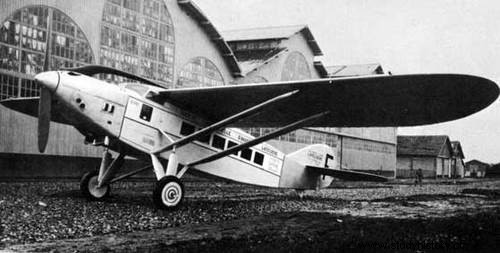
As early as 1930, the French asserted their supremacy there when Mermoz, Dabry and Gimié had. joined Saint-Louis in Natal in nineteen hours and thirty-three minutes on May 12 and 13, on the Comte-de-La-Vaulx, a Laté-28. The return trip came in the grand gesture of aviation. Thwarted by an unfavorable wind, Mermoz will make fifty-two attempts before taking off. All is well until 800 kilometers from Senegal when an oil leak occurs. The engine heats up. The Laté-28 lands narrowly near an aviso alerted by radio. Mermoz and his companions are safe, but the device, the floats punctured, disappears in the waters.
Mermoz arrives in Dakar, his face hard. He drew experience from this eventful journey. He considers that the seaplane is too heavy, unwieldy. He would need a land plane.
There is one, and it's called the Rainbow. It is also the third. The first crashed, in 1927, with Drouhin, who wanted to cross the North Atlantic. The second burned in the fire in its shed. But the third, therefore, is available.
It's a three-engine. The streamlined cabin, with harmonious lines, is made of wood. The engines develop 2,000 HP and can be visited in flight. Who built it ? A stranger, a young man with a pale complexion devoured by the fire of aviation. His name is René Couzinet. Alone and without capital, he, by force of will, built his apparatus. Now he needs a pilot. It will be Mermoz.
The Arc-en-Ciel takes off on January 16, 1933, triumphantly reaches South America, returns to France. Speeches, receptions, laudatory articles, but from the ministry, no grant. However, this fast plane would be an ideal instrument for the Aéropostale... It is precisely because there is no longer an Aéropostale. Its sponsor, Marcel-Bouilloux-Laffont, is harassed by its creditors, attacked by political enemies. There is talk of stopping the operation of the line.
The pilots do not understand. They turn their serious and pure faces towards these conferences of politicians, towards these negotiations of bankers. Is it possible that their fate, that of "their" line, is at the mercy of these people who understand nothing about aviation? Is it to get there that they suffered the burning Sahara and the icy Andes; that they cut an impossible path in the mist or in the night, that they drove, their muscles stiff with fatigue, their devices in the storm or in the snow? Mermoz, Guillaumet, Reine, Saint-Exupéry look at each other:this great epic will therefore have been useless?
This drama, other airmen know it at the same time, and it is inevitable. The era of artisanal and heroic aviation is over. An airline company is now a national affair whose future is no longer in the hands of just a few men.
In December 1932, Air France was born from the merger of all the companies French. As far as the South Atlantic is concerned, the policy of the new leaders is cautious, almost timorous. There is talk of forming a "pool" with Lufthansa, which also operates the line. She solved the problem of long crossings by retracting it. Its devices, Dornier-Wal seaplanes, land near a base ship on which they are hoisted, overhauled, refueled and then catapulted over the sea. The system has proven itself. In February 1936, the Berlin-Buenos Aires line was inaugurated.
It is in a similar jungle that we will live in Indochina, that we will fight, we will rest, we will carry out our action and where we will take refuge after the sabotages. We must therefore know it, know how to use it, know how to benefit from it for our food and our health. “The jungle is neutral,”
